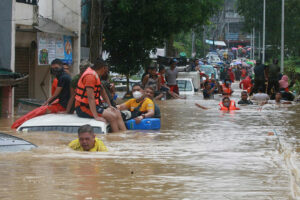THE Philippines needs to take a “whole of society” approach in tackling climate change because of the government’s inability to shoulder the burden on its own, officials said, citing the need for full-scale efforts in mitigating disaster risk and transitioning to renewable energy.
“We need to invest in early warning systems, social protection, resilience building, R&D (research and development), and innovation and technology,” socioeconomic planning Undersecretary Rosemarie G. Edillon said at the Disaster and Climate Emergency Policy Forum on Thursday.
“There are limits to government resources… Government itself is just responsible for 12-15% of GDP (gross domestic product); the rest is really private sector contribution,” she added.
Finance Assistant Secretary Neil Adrian S. Cabiles said at the same event that over the long term, typhoons and earthquakes can inflict P177 billion worth of annual losses to public and private assets in the Philippines.
“In the next 50 years, the country has a 40% chance of experiencing a loss exceeding P989 billion, and a 20% probability of experiencing a loss of as much as P1.5 trillion,” he said.
Bangko Sentral ng Pilipinas Assistant Governor Lyn I. Javier said the resulting risks to the banking sector are substantial.
“With extreme weather episodes, there is a decline in the total deposits, total resources, (and) total loans, while there is an increase in the nonperforming loans of the banks. This would actually impede them, or make it challenging for them, to lend to households, consumers, and businesses,” she said.
“We expect banks to progressively increase their exposure to sustainable projects, and also assist their borrowers in terms of transitioning and being resilient to the impact of climate change and other environmental risks,” she added.
Ms. Edillon said that responsible consumption and production, or sustainable development goal (SDG) 12, is at the heart of all SDGs, prompting the creation of a Philippine Action Plan for that specific purpose.
“It’s about editing those choices, editing those menu(s), so that people will just choose from those sustainable consumption and production goods,” Ms. Edillon said, noting the importance of R&D, innovation, and technology.
“We need to provide them the options (and) alternatives to these unsustainable goods and services, and then, of course, the infrastructure is needed to be in place so that we encourage the sustainable behavior and discourage the unsustainable behavior.”
However, implementors face a lack of institutional capacity, both in terms of knowledge and funding.
“The estimated cost to implement climate change mitigation actions for the sectors of energy, forestry, industry, and transport alone is around $4.12 billion from 2015 to 2030,” Mr. Cabiles said, noting how this does not yet include the costs the Philippines shoulders to fulfill its Nationally Determined Contribution commitment of reducing greenhouse gas emissions by 75%.
Robert E.A. Borje, vice-chairman of the Climate Change Commission (CCC) said that the current funding access of the Philippines for climate change initiatives is low compared to other countries.
“The CCC identified only P74 billion worth of financial support committed for 15 climate change projects from 2022 onwards. Why do I say this with a little trepidation? Because the grants amount to only to P6.9 billion and the loans are P67.1 billion,” he said.
“The position of the Philippines is that while we want a mix or a blend of financing, as a developing country, we need better access to grants.”
Budget Assistant Secretary Romeo Matthew T. Balanquit said P338.2 billion was allocated for adaptation projects next year under the proposed budget, against P114.9 billion this year. He added that the government’s efforts are aimed at minimizing the negative effects of extreme weather events to help ensure the attainment of national development targets.
The government hopes to expand the economy by 6.5-7.5% this year, and by 6.5-8% next year until 2028.
Energy Undersecretary Felix William B. Fuentebella said that the department hopes to raise the share of renewable energy (RE) in the fuel mix to 35% by 2030 and 50% by 2040.
“We have seen that we have a lot of (fuel) imports, and what happens when the dollar goes up against the peso. So where’s the opportunity? We really have to pursue RE,” he said.
“Six years ago, it was difficult to push for RE because of the cost; now it’s easier (because costs have fallen).”
Albay Rep. Jose Ma. Clemente S. Salceda said that RE can help solve the problem of high power rates that disincentivize investors from doing business in the Philippines.
“Rapid, inclusive growth requires cheap renewable energy, and cheap energy can come from a combination of dependable base load, a surplus of renewable, and setting aside legacy issues for a fresh start,” he said.
He said the main obstacles to expanding RE involve restrictions on foreign capital.
“RE is subject to (the) 60-40 rule,” he said, referring to the constitutional cap of 40% on foreign investment in some industries. “So, foreign investors can’t come in.”
“We need to liberalize renewable energy. If you really want this thing to be solved, you really need to push RE to a massive surplus. We need to regulate distribution, especially for renewables; allowing households to distribute to each other.” — Diego Gabriel C. Robles
